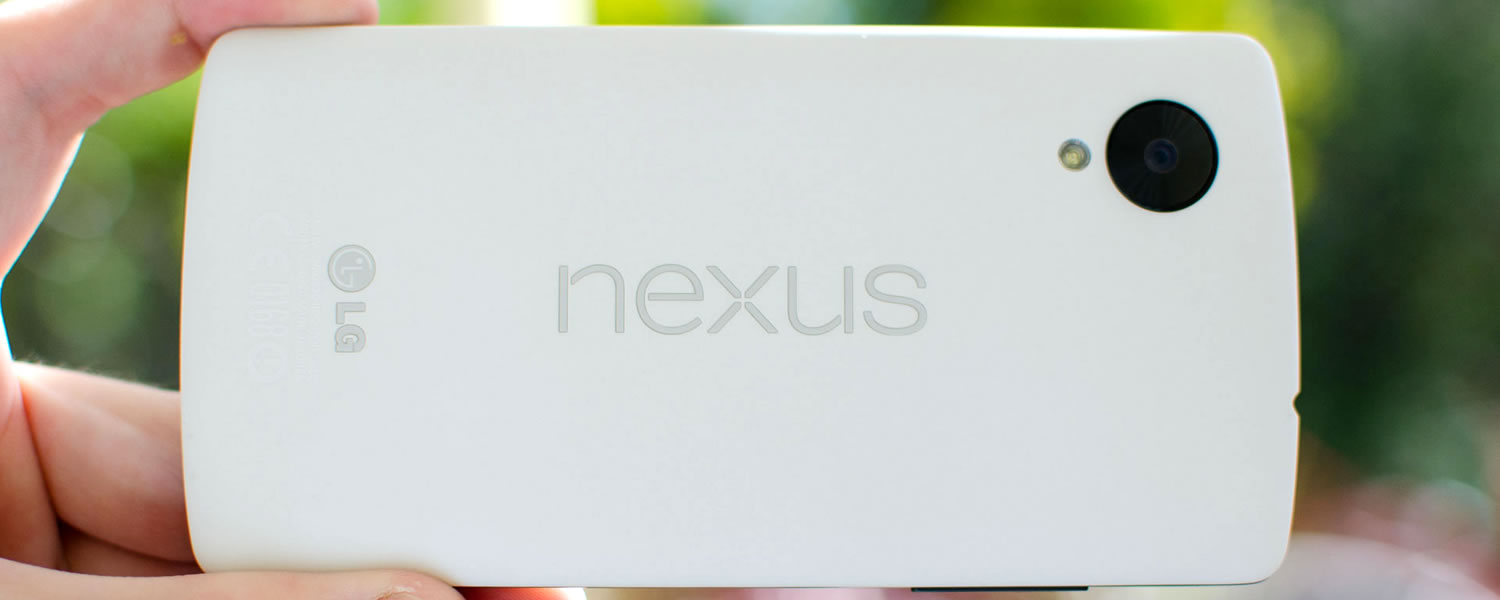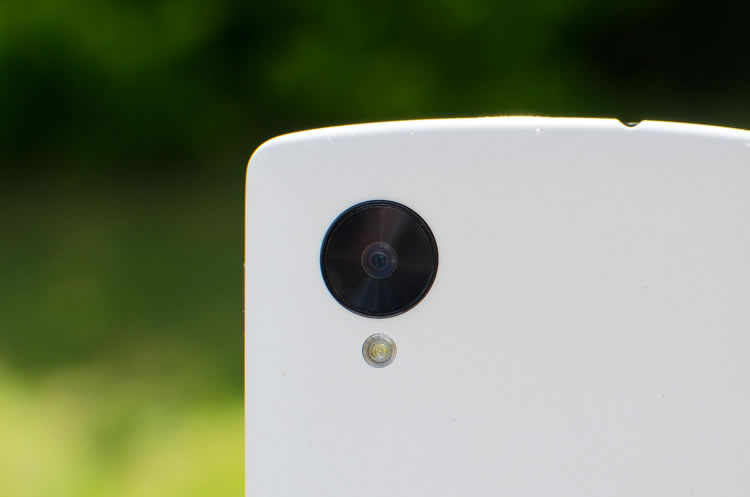It's that time of the year again, where Google releases a new Nexus handset for those wanting a cheap yet powerful device running stock Android. 2013's Nexus is the Nexus 5, aptly named as it's both the fifth Nexus device and it packs a five-inch display. Like its predecessor, the Nexus 4, this new device is produced by LG and packs many similarities to the LG G2, which is the company's more expensive flagship mode.
Google Nexus 5 - $349 - $399 (unlocked)
- 5.0", 1920 x 1080 IPS LCD display (441 ppi)
- Qualcomm Snapdragon 800 SoC
- 2.3 GHz quad-core CPU, Adreno 330 GPU, 2GB RAM
- 16 or 32 GB internal storage
- 8 MP camera, 1/3.2" sensor, f/2.4 lens, 1080p video
- 2,300 mAh, 8 Wh battery
- LTE, Wi-Fi a/b/g/n/ac, Bluetooth 4.0, NFC
- Stock Android 4.4 'KitKat'
- 130 grams, 8.6mm thick
Despite its low price - $349 for an unlocked 16 GB model - the Nexus 5 packs top-of-the-line specifications. Internally there's a Qualcomm Snapdragon 800 SoC with a 2.3 GHz quad-core CPU, 2 GB of RAM, LTE radios worldwide (a first for Nexus devices) and a 2,300 mAh battery, complemented by a 4.95-inch 1080p IPS display. Let's not forget the camera either, which is an 8-megapixel unit and will hopefully prove much more capable than the Nexus cameras of the past.
The Nexus 5 is the first device to come with Android 4.4 'KitKat' out of the box, which brings a few improvements to the Android ecosystem, most notably a refined interface, performance optimizations and messaging integrated into Hangouts. As a purely vanilla device, this is the Android experience Google is after, and it will surely be interesting to see how well the hardware fits the software.
The Google Nexus 5 (16 GB LG-D820) used in this review was kindly provided by Negri Electronics. No matter where you are in the world (including Australia, US, and abroad), Negri will provide you unlocked smartphones and tablets first and for the lowest prices - and they have plenty of Nexus 5s in stock!
Design
The Nexus 5 features a basic, no fuss yet svelte design that perfectly matches the design language of Android 4.4. The long edges of the device are straight and flat, with little tapering to either side, while the top and bottom edges are curved slightly for ergonomics and looks. The squarish design isn't as comfortable to hold as the Samsung Galaxy S4 or LG G2, but its relatively small profile with minimal bezel keeps the phone as pocketable as the Nexus 4.
In fact the phone is almost identical in dimensions to the Nexus 4: it's 4 mm taller, 0.4mm wider and 0.5mm thinner; yet it has a display that's 0.3-inches larger. In terms of z-height, the Nexus 5 comes in at 8.6mm thick on average, with a maximum thickness of 9.45mm at the slightly protruding camera. In the hand it feels neither hugely thick nor unusually thin, and its reasonable weight of 130 grams makes the device quite portable.
The front panel of the Nexus 5 is pretty much as minimalist as phones come. Above the 4.95-inch display sits a round, indented in-call speaker, to the left of which is a small front-facing camera, and to the right is a nearly invisible sensor array. As the handset makes use of Android's onscreen buttons, below the display is nothing but a multi-colored glowing notification orb, similar to what was seen on the Nexus 7 tablet. The display itself covers roughly 71% of the front profile, which is comparable to the Galaxy S4 (72%) and an improvement on the Nexus 4 (66%).
The back of the handset should be familiar to anyone who has a 2013-model Nexus 7. There's prominent landscape-oriented Nexus branding, a small LG logo beneath and a sizable camera unit. One of the few aspects of the Nexus 5's design I'm not particularly fond of is the large black ring around the camera, however it appears to be magnetic, which could mean some interesting camera lens attachments are on their way.
Around the edges of the device there's the usual array of features. The left hand side has the volume rocker, the top has the 3.5mm headphone jack, the bottom sees the USB port and two speaker grills (of which only the left has a speaker behind) and the left side has the power button. For my average-sized hands the power button is a little higher than I would have liked, being seated near the very top of the left side, but it's still in a better position than if it was on the actual top edge.
The build quality of the Nexus 5 is slightly above that of the LG G2, despite the latter device being LG's premium offering. This is mostly due to the soft-touch polycarbonate back panel that, thanks to its matte finish, doesn't feel as cheap as the smooth, glossy plastic found on other devices. Yes, the edges are made from glossy plastic, but it's the back panel that you'll be feeling the most, and I appreciate the Lumia-like plastic LG has used there.
The entire front panel is protected by Gorilla Glass 3, which is smooth to touch and swipe, as well as tough and scratch resistant. The bezels to the left and right of the display, which measure 3mm each, make the phone easy to use in one hand, and there's a very slight plastic edge around the glass that might help when you drop the phone face-down.
As you might have noticed, the model I received for review is white, however the only actual part of the device that's white is the back panel. With the edges and front still black, the two-toned design it produces looks quite nice, and although the color you end up choosing is entirely subjective, my preference definitely swings towards this white unit. If you do get the black unit, I hear the plastic used on the back panel is slightly softer to touch, but otherwise the phones are identical build-wise.
For an inexpensive yet high-end device, I was very impressed with what the design of the Nexus 5 brings to the table. There's no flashy holographic back plate like with the Nexus 4, but the successor's build is higher quality than the price tag suggests, and it suits the operating system it runs very well.
Display
If you think LG might have skimped on the display in the Nexus 5, think again. It's not the exact same panel that is seen in the LG G2, but in many ways it comes close. You get a 4.95-inch IPS TFT LCD display with a resolution of 1920 x 1080 (1080p), bringing pixel density to 445 pixels per inch (ppi); specifications that are comparable to other flagship Android devices on the market right now.
With the Nexus 5's software making use of onscreen buttons, the effective screen real estate is reduced from 4.95-inches to 4.67-inches with a resolution of 1776 x 1080. The onscreen buttons are easy to access and in a comfortable position, plus there's the usual benefits where they disappear in certain applications that need to use the entire display, such as the video player. Unlike the LG G2 you can't change the buttons, but the default selection of back, home and the recent apps menu is functional and there's no legacy menu button to interfere with the current Android design.
The LCD panel found in the Nexus 5 displays fantastic color quality, as you would expect from the IPS technology used. Colors are balanced and realistic, yet vibrant and eye-catching, which is exactly what you're looking for in a smartphone's display. Looking at test patterns reveals red is the display's most dominant color, while there is little to no color banding, indicating the display has a wide color gamut.
Contrast from the panel is superb, producing strong untinted white levels and deep blacks, which makes reading text easy. When analyzing black levels, it was possible to discern all but one of the difference squares in a test pattern, and with white levels every square is visible. There is very slight backlight bleeding around the edges of the display, which affects the evenness of dark images, but it's unlikely you'll notice this in everyday usage. Gamma values sit around 2.0, which isn't the best it could be (the ideal value is 2.2), but better in comparison to other panels, such as the Xperia Z1's.
The Nexus 5's viewing angles are very good; vertical off-angle viewing is slightly better than horizontal off-angle viewing, but in both situations there is little contrast and color distortion, which keeps the display readable in a variety of situations. I was very pleased with the brightness range as well, which alongside a polarization filter helps keep the display readable in direct sunlight, and at night it ramps down enough - perhaps even further than usual - so that your eyes don't get irritated. Autobrightness is quick and responsive, which again is great to see.
1080p and 445ppi is a fantastic mix of crispness and clarity that allows this display to look like paper, similar to many other high-end phones you can get today. Many people today believe that 720p is truly all you need in terms of display resolution, but once you compare 720p to 1080p and start using it on a daily basis, you simply can't go back. It provides an extra level of detail that's especially noticeable when reading text, and no matter how closely you view the display, you won't notice the millions of individual pixels spread across the 68.9 square centimeter screen.
Through using an LCD panel rather than AMOLED, LG has avoided the issues associated with PenTile subpixel matrices, so this display (like most other LCDs) has your standard RGB stripe. The edges of text are so sharp and so clear that it rivals printed words, while the level of detail you can see in photos is astonishing. Let's not forget that a resolution of 1920 x 1080 means you can watch Blu-ray-quality videos without a loss in detail from upscaling or downscaling, so the crispness transfers to movies as well.
If this display was found on a $700 handset, I would find little to complain about, making its inclusion on a $350 device even more impressive. Not only is the panel bright, crisp and high-resolution, but it's also large and exhibits strong color quality: a combination which should leave no Nexus 5 buyer disappointed.













